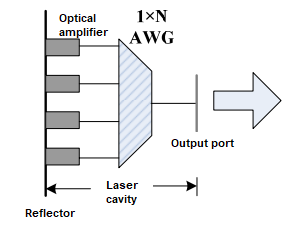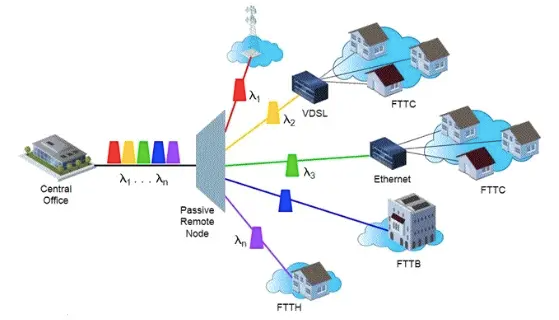In order to provide higher bandwidth in the access network, operators around the world have begun to implement the plan of replacing copper cables with fiber optic cables and deploy passive optical networks represented by EPON and GPON. Technically speaking, both EPON and GPON work in the time division multiplexing mode, which are collectively called TDM-PON.
The mechanism of TDM-PON allocating time slices to each user on a single wavelength not only limits the available bandwidth of each user, but also greatly wastes the available bandwidth of the optical fiber itself. Introducing wavelength division multiplexing technology into the PON system, that is, WDM-PON, will greatly increase users’ access bandwidth and meet the ultimate needs of users. Therefore, WDM-PON is considered a solution for the next generation access network.
Light source of transmitter
1、ONU light source
Various ONU light source technologies in the WDM-PON system belong to the category of single-wavelength light sources. FP-LD and RSOA are the realization technologies of the colorless ONU mainly used in the current WDM-PON system. FP-LD has been widely used in the current optical communication system. Although the FP-LD used in the WDM-PON system is slightly different (for example, the reflectivity of the front surface is required to be low and the rear surface is high), its cost is still low, and output is large. As for SOA, it has multiple applications in optical networks and optical modules besides being used as an amplifier. Its nonlinear effect can also be used to realize modulation, wavelength conversion, regeneration, and high-speed (especially above 40 Gb/s) optical switching and other functions. The reflective device RSOA can be obtained by slightly modifying its structure, which is especially useful in WDM-PON systems.
In general, although SOA/RSOA devices have various functions and mature processes, and can optimize parameters for different applications, they are still regarded as being in the laboratory application stage, and the commercial market is only in its infancy, and there is currently no driving force for widespread adoption of SOA/RSOA devices. There are not many suppliers of SOA/RSOA products in the world. The large ones include CIP in the UK and Kamelian in Scotland. ETRI in South Korea is also developing RSOA devices for WDM-PON systems and providing them to Corecess. However, the price of RSOA devices used for WDM-PON is expensive at present, so the scale of production is required to further reduce the cost.
2、OLT light source
For OLT, since it needs to use different wavelengths to communicate with each ONU, it is very inconvenient to use this single-wavelength light source solution. The OLT light source can also use spectrum division of the wide-spectrum light source, but the spectrum division will introduce a large loss (about 18 dB), it will cause a tight power budget, so, at present, multi-wavelength light sources are mainly used. The multi-wavelength light source is on an integrated device that can generate multiple wavelengths of light at the same time, and it is very suitable for use as an OLT light source in a WDM-PON system. There are the following types of multi-wavelength light sources.
Multi-frequency laser (MFL): As shown in Figure, in the multi-frequency laser, a 1×N arrayed waveguide grating and multiple optical amplifiers are integrated, and each input end of the arrayed waveguide grating integrates an optical amplifier. An optical cavity is formed between the optical amplifier and the output end of the arrayed waveguide grating. If the amplifier provides enough gain to overcome the loss in the cavity, there will be laser output, and the output wavelength is determined by the filtering characteristics of the arrayed waveguide grating. By directly modulating the bias current of each amplifier, multi-wavelength downlink signals can be generated.

The wavelength interval of the MFL is determined by the waveguide length difference in the arrayed waveguide grating, which can be precisely controlled. Each wavelength can be adjusted uniformly by keeping the same temperature, which is convenient for wavelength monitoring. The MLF is an ideal OLT light source. Direct modulation is also possible in multi-frequency lasers, but the modulation speed is limited due to the long laser cavity. The MFL with 200 GHz and 20-channel spacing, and with 400 GHz and 16 channel spacing have been launched, whose direct modulation rate is 622 Mbit/s.
Gain-coupled DFB laser array: DFB laser array manufactures multiple InGaAsP/InP multi-quantum well waveguide lasers with the same properties on the same substrate, and it is an integrated multi-wavelength light source. DFB laser arrays combine a gain-coupling mechanism with tuning capabilities on one laser module, and wavelength tuning is achieved through temperature control. Thin-film resistors are integrated on the device, and the wavelength can be changed by controlling its temperature, which allows near continuous tuning. The advantage of this device lies in its compact size and high-speed modulation, but it has a major problem, which is that it is difficult to precisely control the wavelength of each laser in the array, because each laser wavelength is determined by an independent filter.
Supercontinuum laser light source: A femtosecond pulse is generated by a femtosecond laser, and after transmission through a nonlinear medium, pulse extension and linear frequency chirp are caused by the self-phase modulation effect. On the broadened spectrum, the wavelength increases linearly with time, so different wavelengths occupy different time slots, and the downlink data is modulated on each channel by TDM. The broadened spectrum can be amplified and split to support multiple PONs to be shared by a large number of users.
WDM
In WDM-PON, a wavelength division multiplexer is usually called a wavelength router. It de-multiplexes the downlink signal and distributes it to a designated ONU and multiplexes the uplink signal into an optical fiber and transmits it to the OLT. Its main indicators include insertion loss, crosstalk, channel spacing, polarization dependence, and temperature sensitivity.

At present, there are devices with various structures, such as thin film interference filters, acousto-optic filters, fiber Bragg gratings, AWGs, etc. In the case of a small number of channels, thin-film interference filters and fiber gratings are good choices. For WDM systems with more than 16 channels, AWG is mostly used for multiplexing/demultiplexing devices, mainly because the loss of AWG has nothing to do with the number of channels. The arrayed waveguide grating developed in recent years has the advantages of small size, easy integration, narrow channel spacing, and stable performance, which promotes the development of WDM-PON.
Although AWG has been widely used in DWDM systems, when it is applied to PON networks, it cannot use active temperature control devices, and it will face the problem of wavelength drift caused by temperature changes. Therefore, heat- insensitive AWGs are critical to WDM-PON systems. The heat-insensitive AWG technology is relatively mature, but the price is higher than ordinary AWG. If it can be mass-produced and widely used, the cost will be basically the same as that of ordinary AWG.
WDM receiver
The receiver in the WDM-PON system includes a photodetector and an accompanying circuit for signal recovery (digital optical receiver). PIN photodiodes and avalanche photodiodes are commonly used photodetectors, which have different applications depending on the sensitivity required. A digital optical receiver usually consists of a preamplifier, a main amplifier, and a clock data recovery circuit (CDR).
The receiver in WDM-PON consists of a de-multiplexer and a receiver array. In a WDM receiver, linear crosstalk at the demultiplexer needs to be considered, which causes a rapid increase in power loss. Methods for controlling crosstalk include equalizing the power from each ONU, double filtering the received signal, and so on.
Wavelength monitoring
Since multiple wavelengths are used in WDM-PON, and since the AWG is generally placed in the open air without temperature control, temperature has a major influence on the change of the AWG passband. Generally speaking, the temperature difference range of AWG is -40~85°C, and the passband shift rate is 0.011nm/°C. Therefore, at such a temperature difference, there will be a 1.4 nm shift in wavelength. Such an offset will be on the same order of magnitudes (100~200GHz) as the wavelength interval of DWDM, which will seriously affect the work of WDM-PON. Therefore, it is necessary to perform wavelength detection and tuning work in the OLT.
Wavelength monitoring uses a differential algorithm to compare the transmission power of a channel with the power passing through the wavelength router to obtain a difference signal. If it is less than the difference signal at the previous moment, the temperature will change by ΔT in the current direction. Otherwise, it means that the channel mismatch increases, and temperature will change ΔT in the opposite direction. In this method, the speed and step distance ΔT of temperature adjustment should be selected appropriately.
Wavelength monitoring can be realized by monitoring downlink channel power and uplink channel power. For composite PONs that only use WDM in the downlink, only downlink channel power can be monitored. This method requires additional loopback fibers, or a monitoring channel and fiber grating. For WDM-PON using spectrum split uplink, you can compare the uplink signal power before and after demultiplexing at the OLT, and only need to add a coupler for wavelength monitoring without additional channels.


























